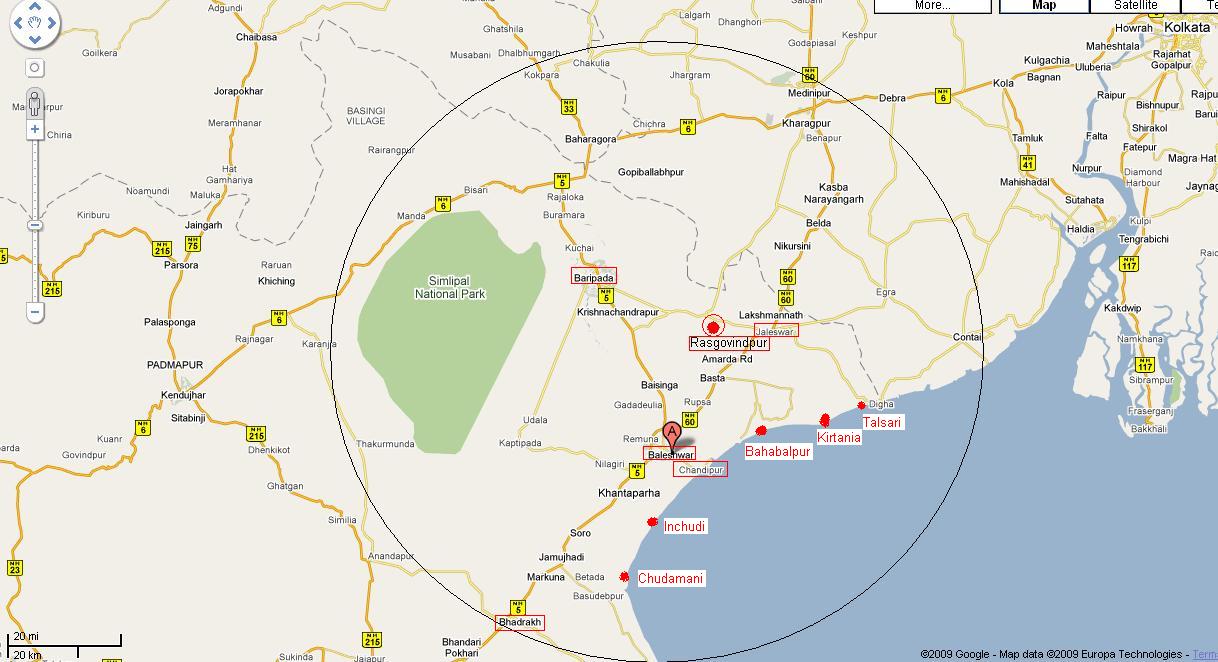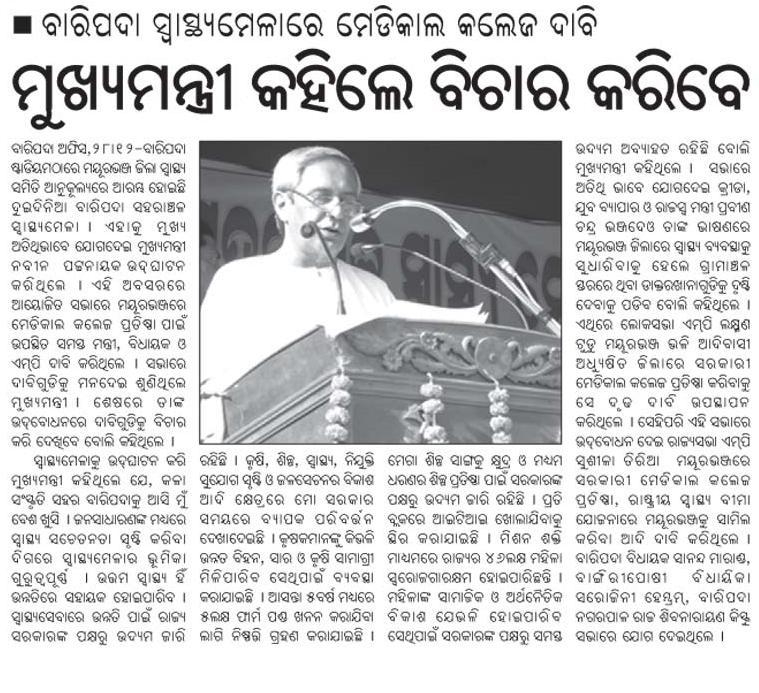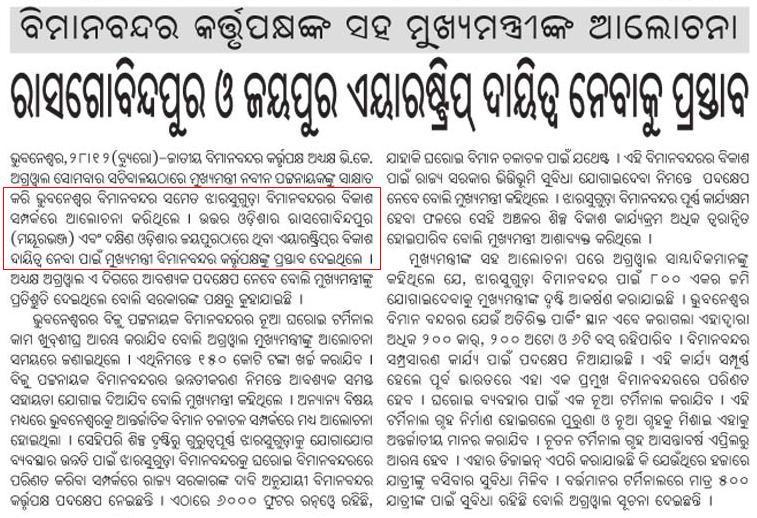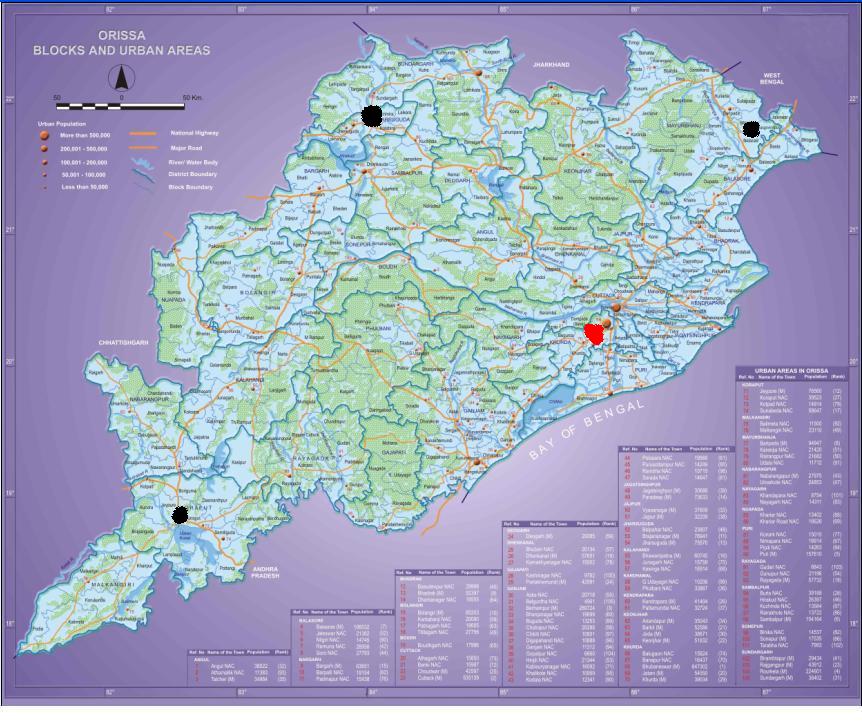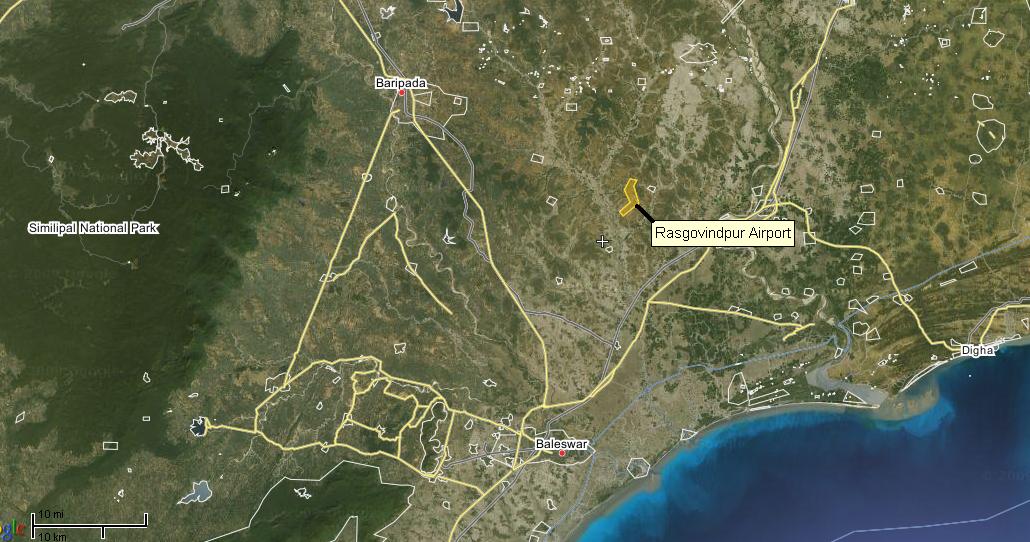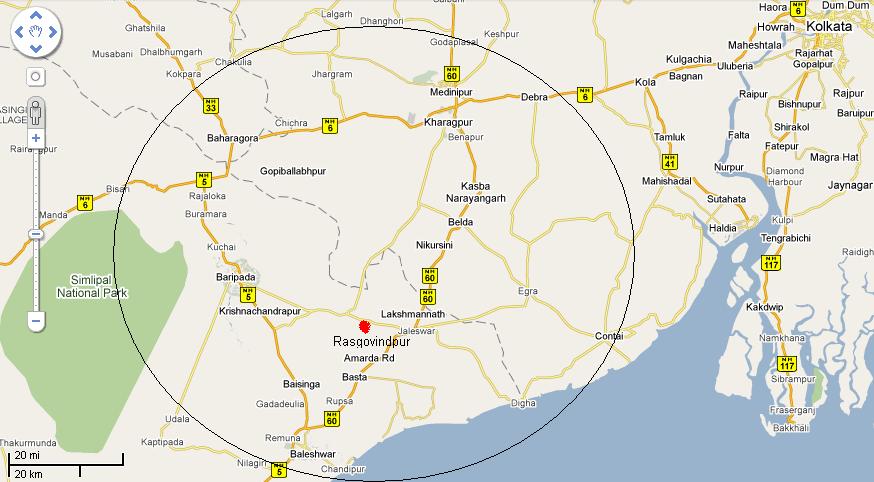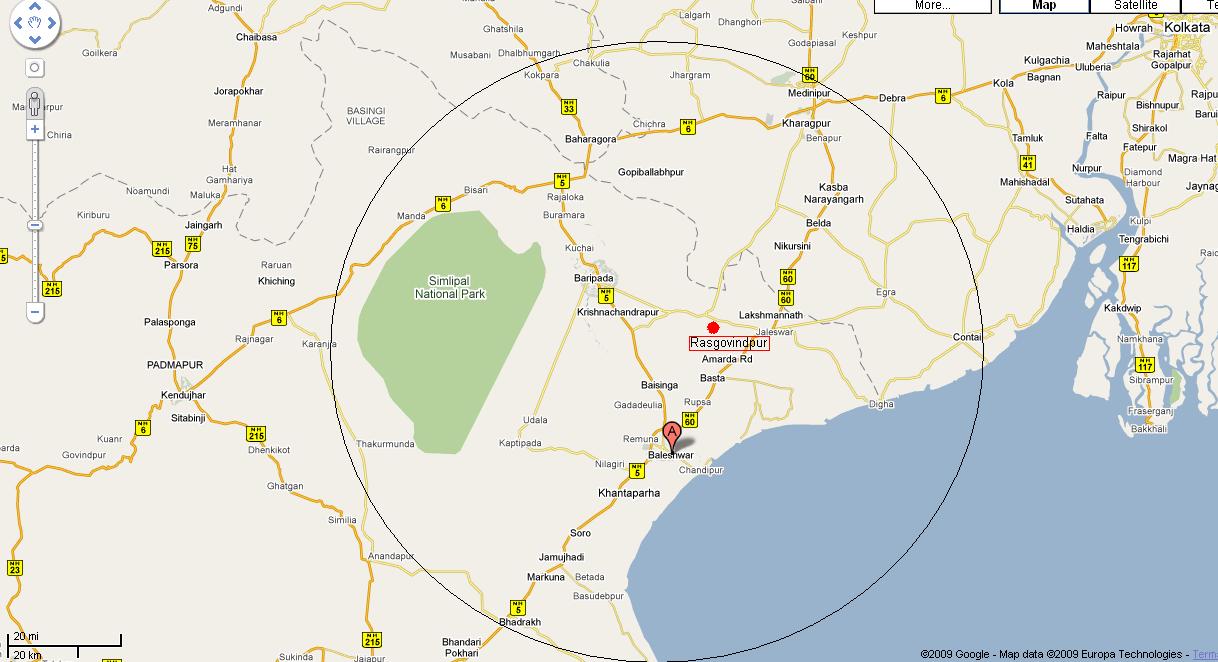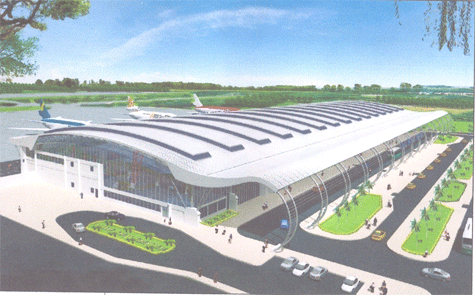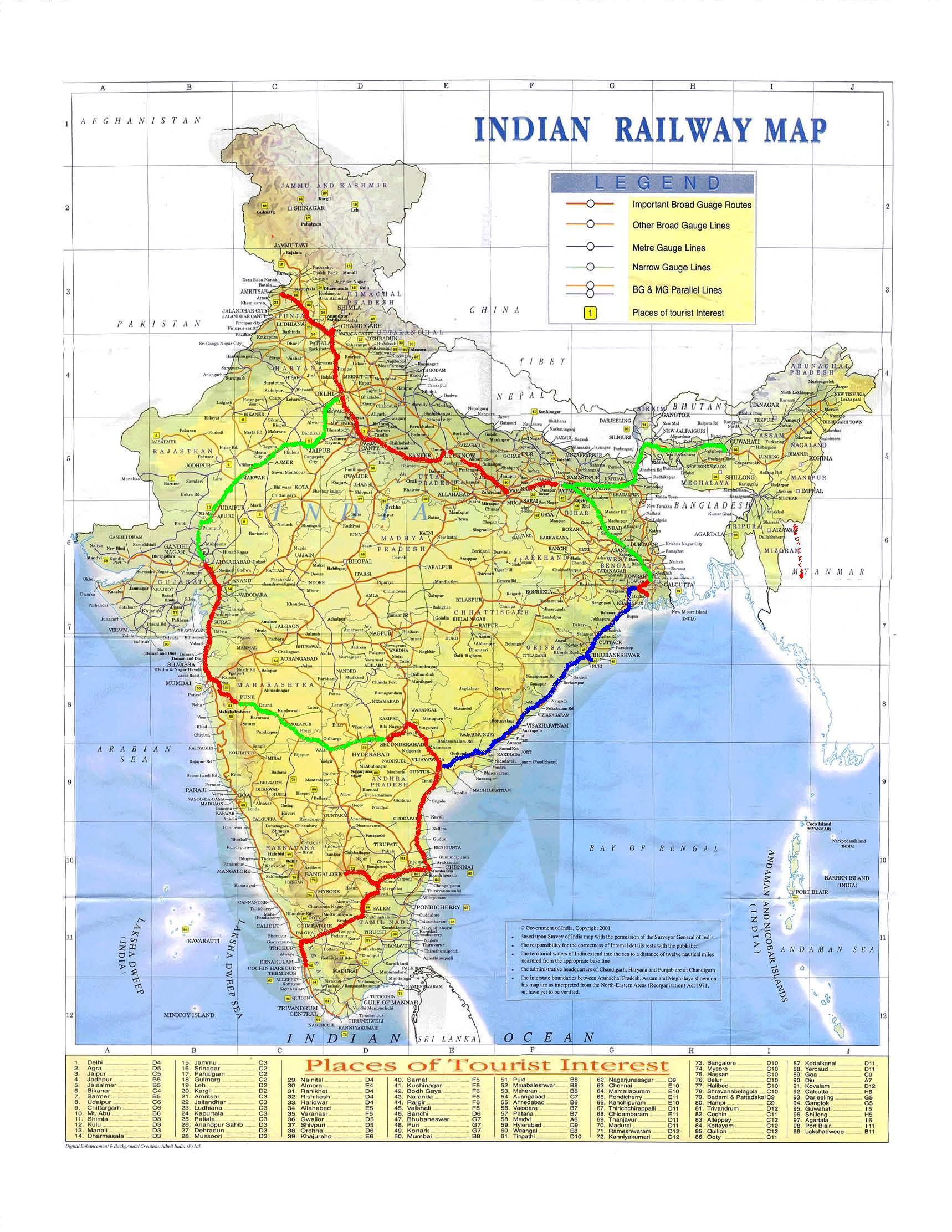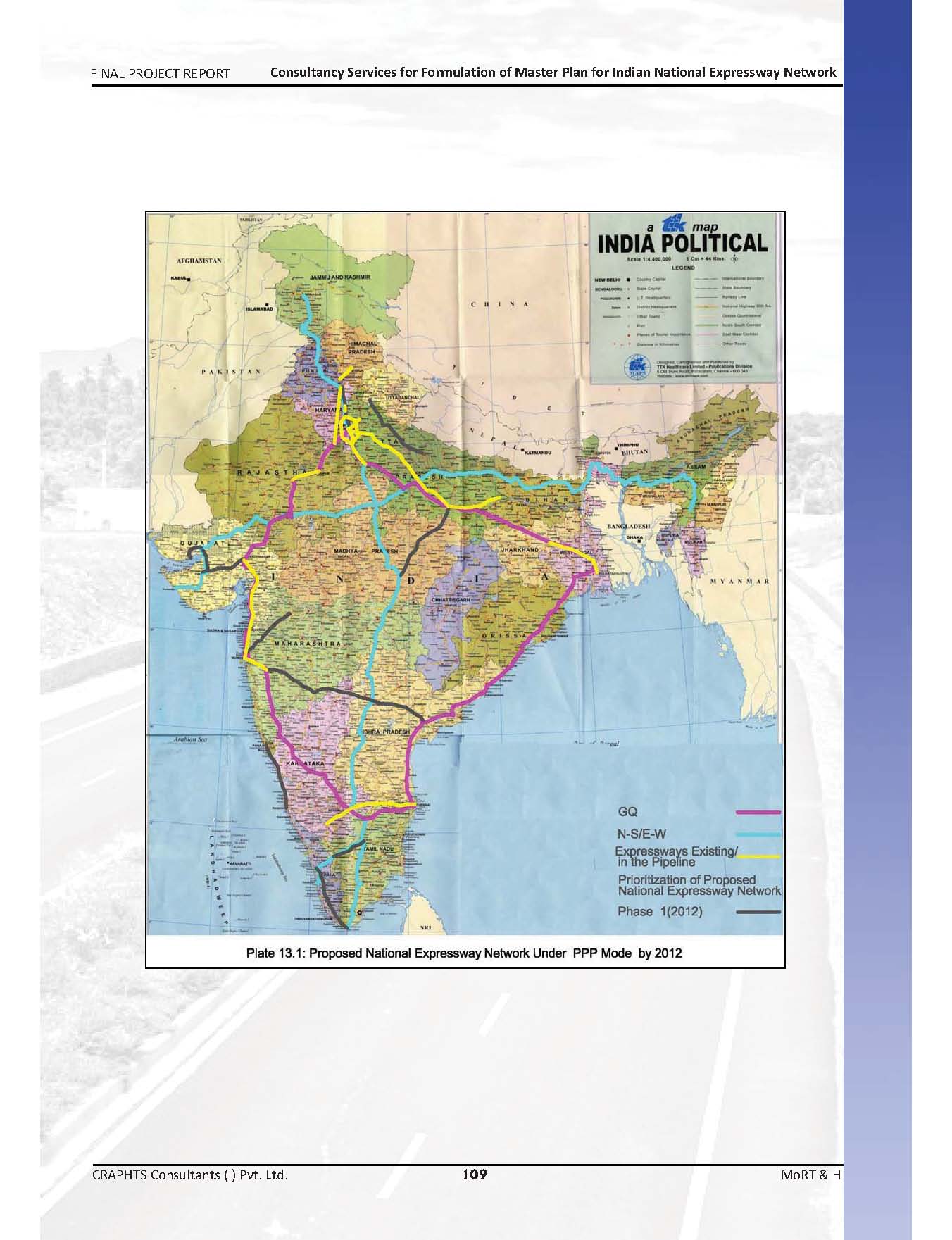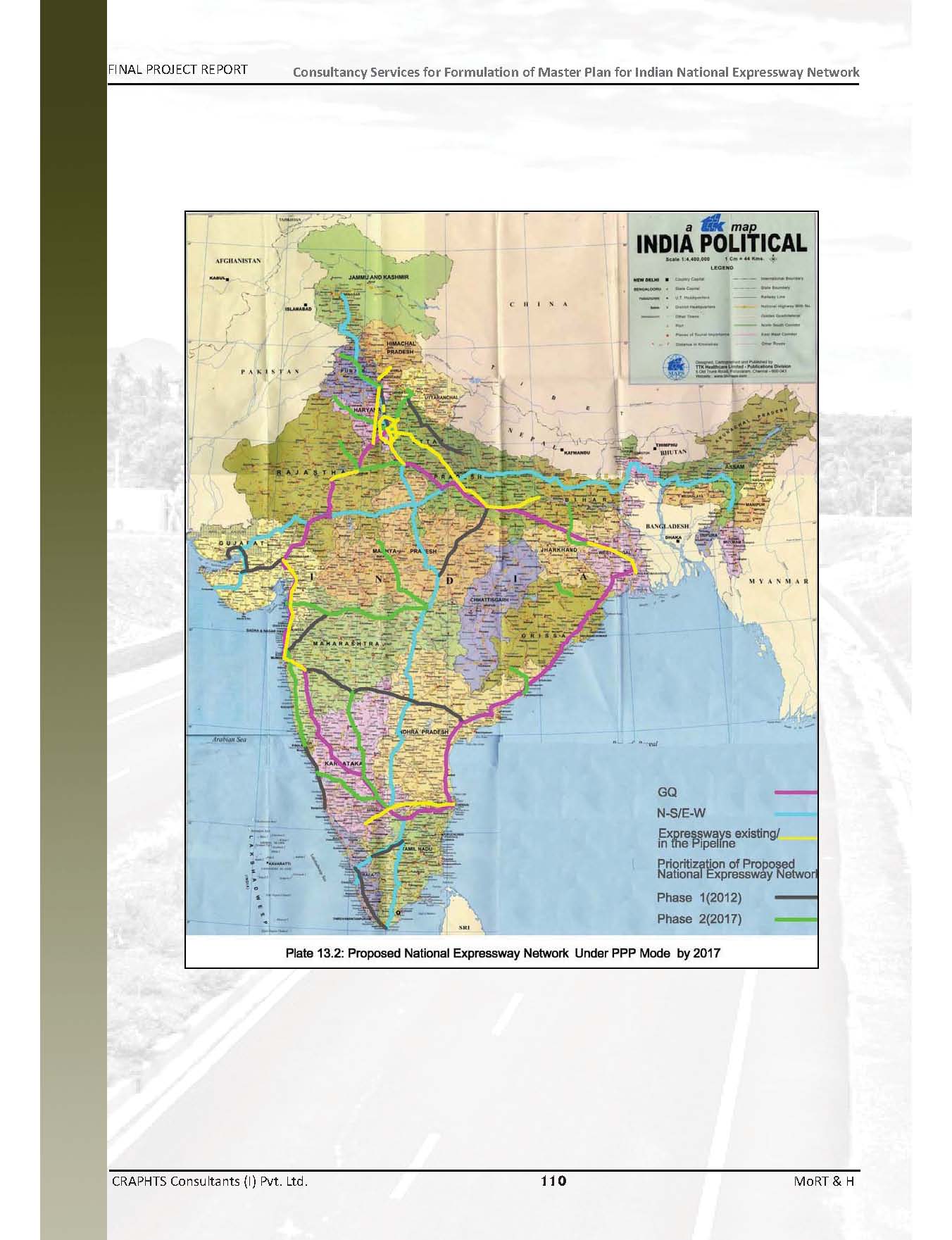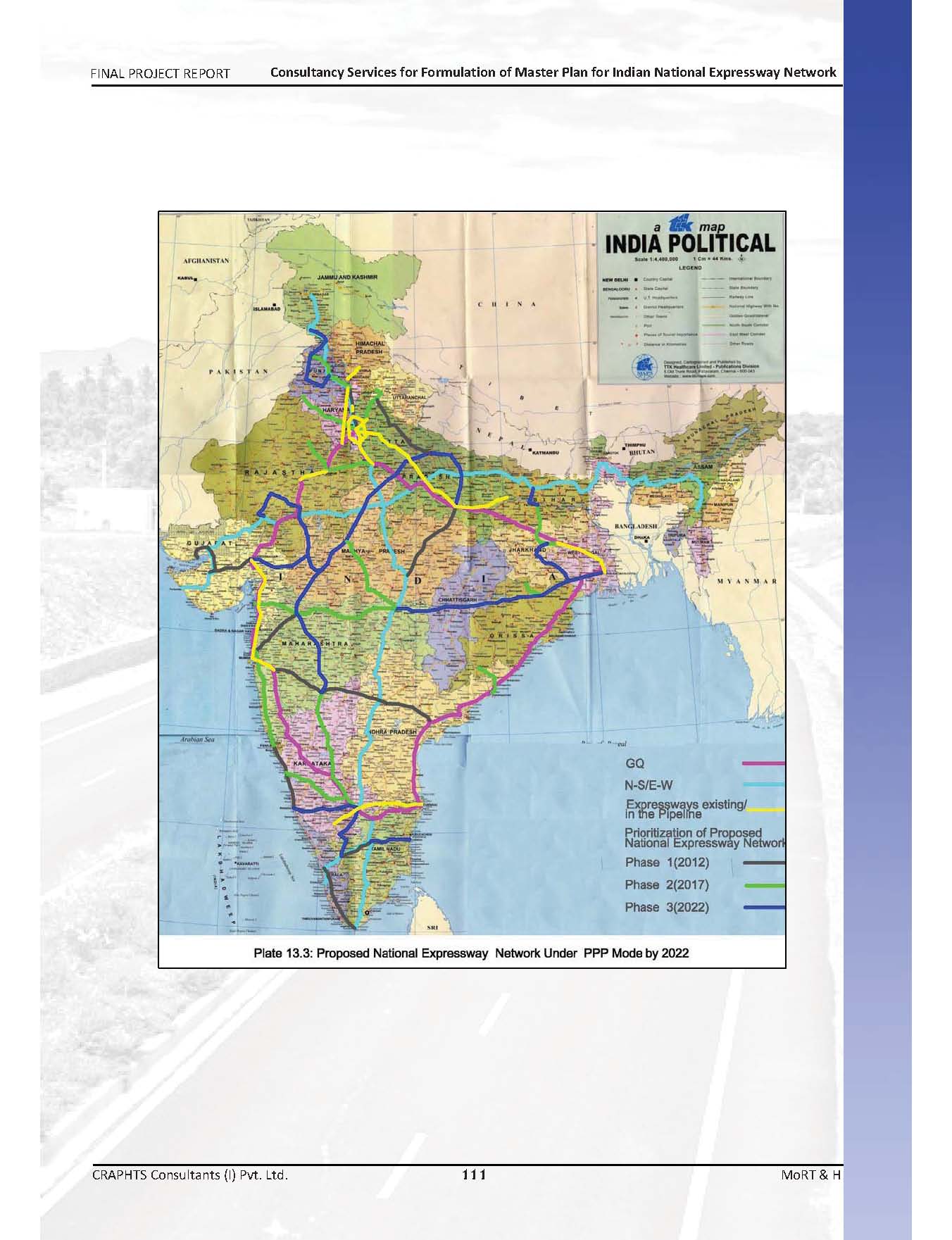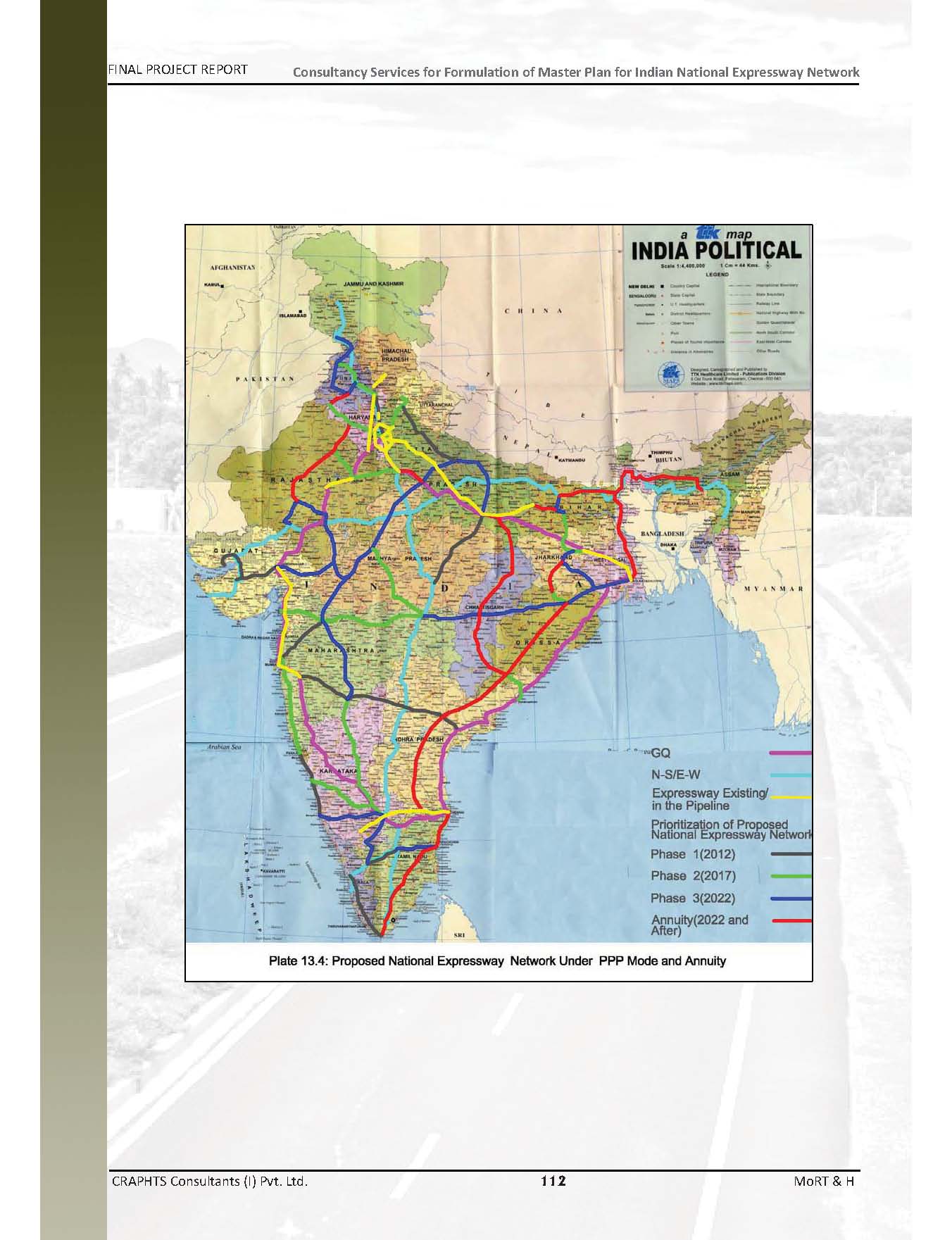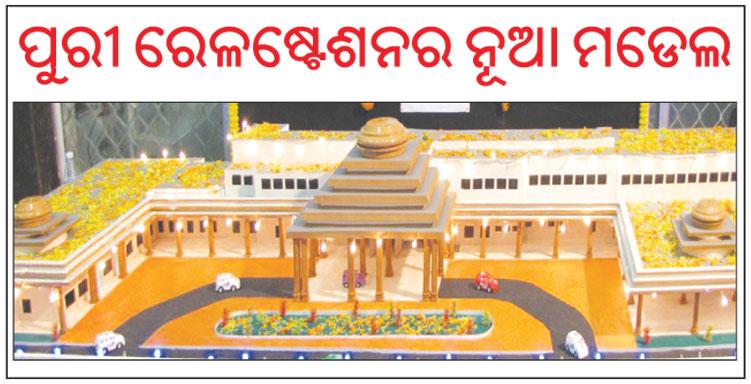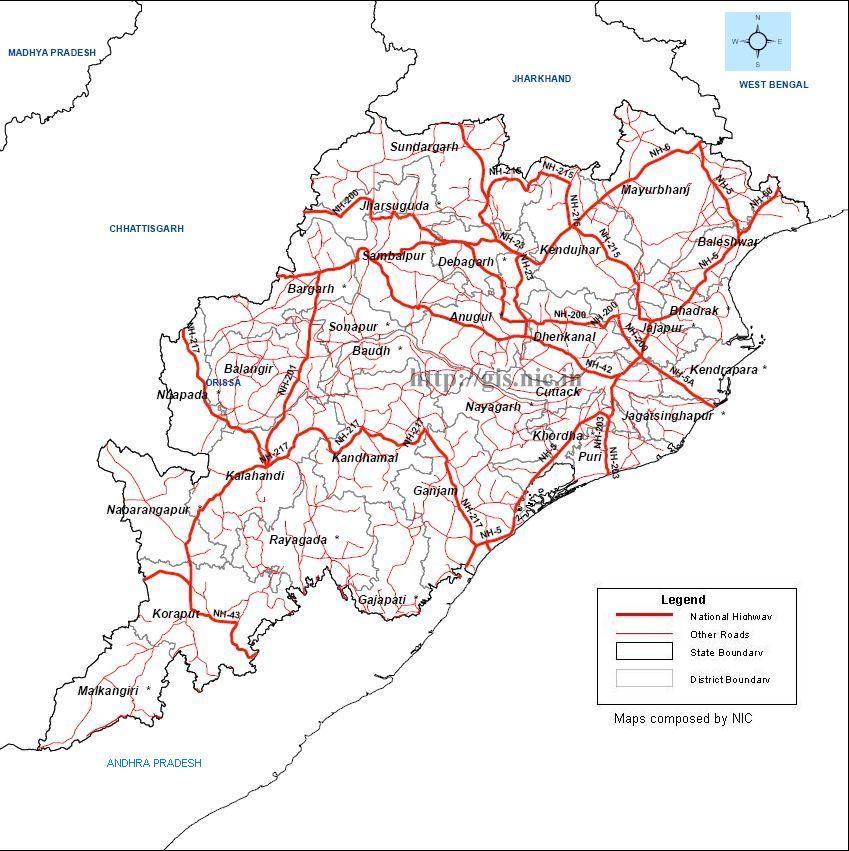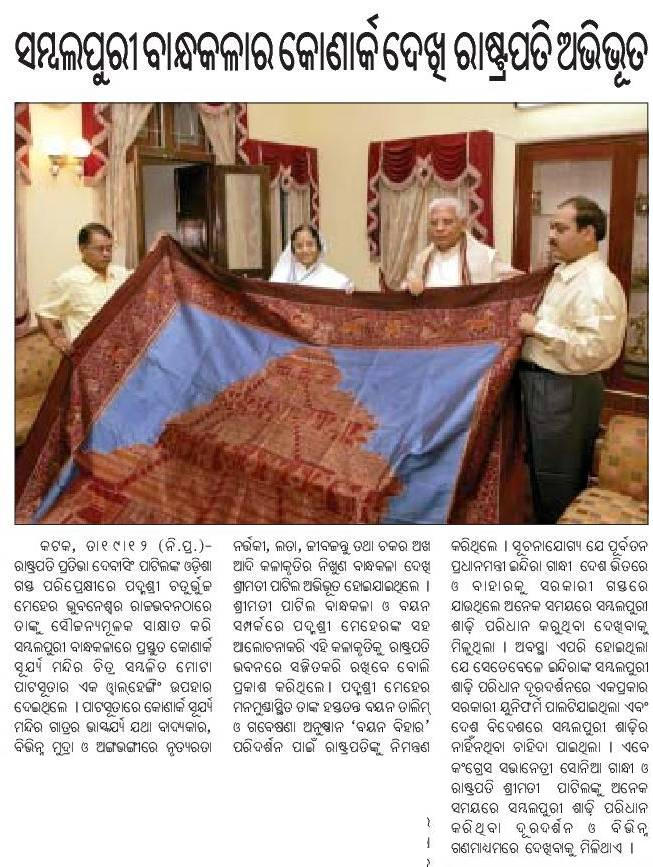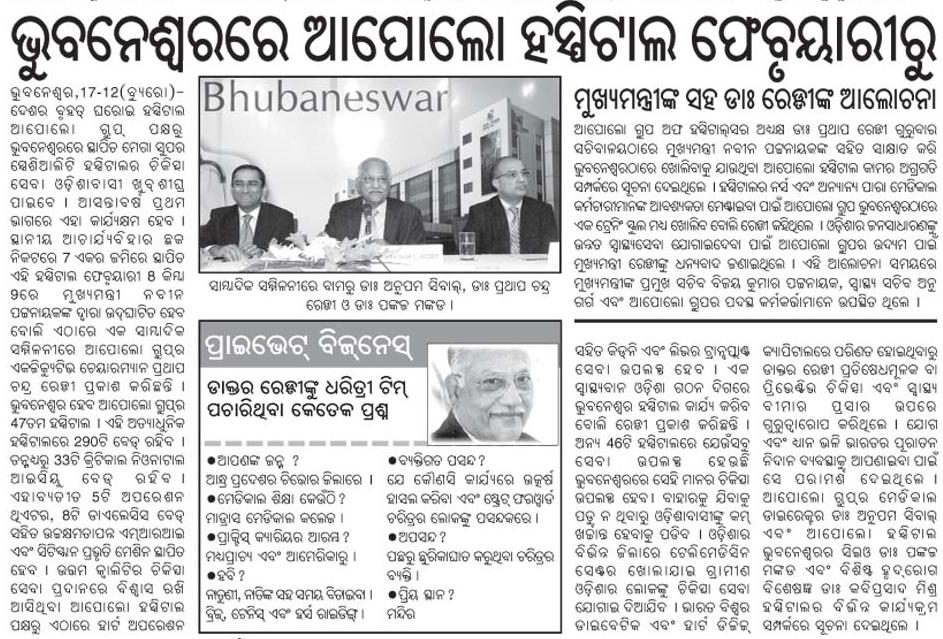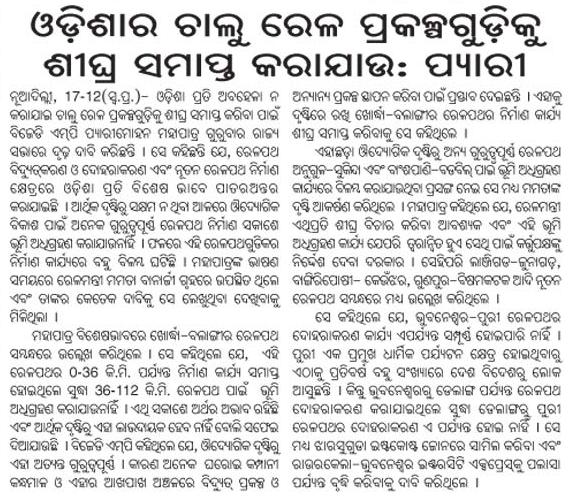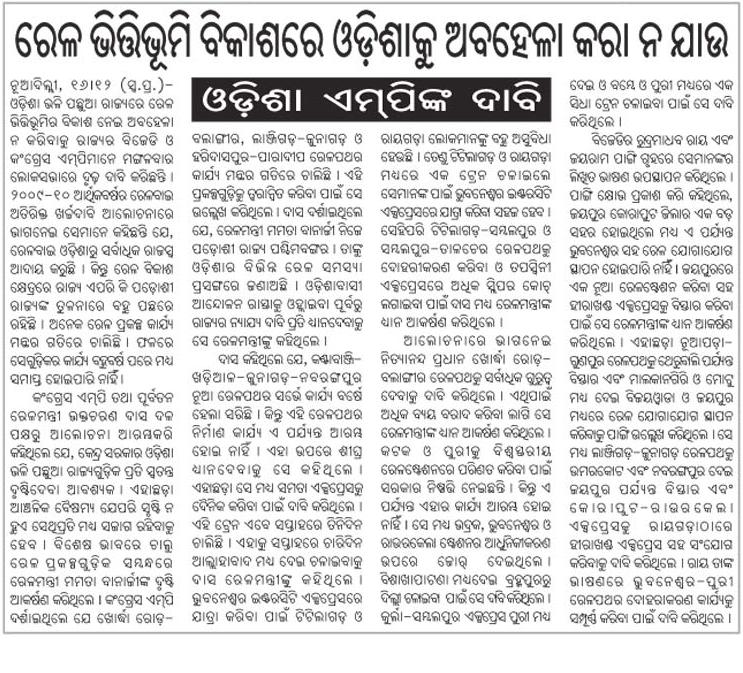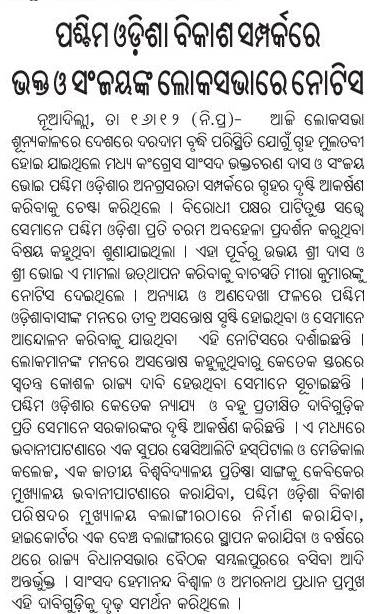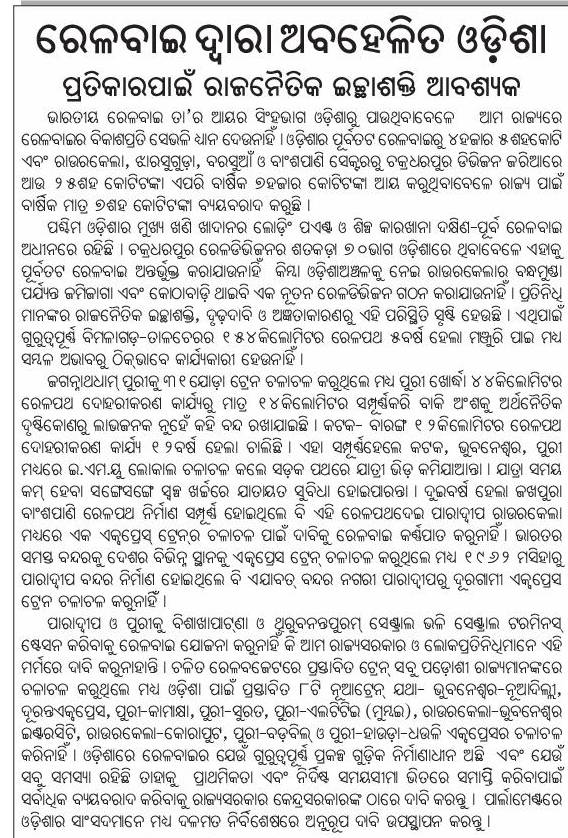The document is at http://www.indianrailways.gov.in/DEPTTS/Infrastructure/VISION%202020_Eng_SUBMITTED%20TO%20PARLIAMENT.pdf.
Following are some excerpts related to Indian Railways operation in Orissa.
… the Vision proposes to add 25,000 kms of New Lines by 2020, supported by government funding and a major increase in Public Private Partnerships (PPPs). Of this, at least 10,000 kms would be socially desirable lines regardless of their economic viability in the short run. This will, of course, include the completion of the backlog of 11,985 kms of lines already sanctioned.
The Vision 2020 also envisages the implementation of at least 4 high-speed rail projects to provide bullet train services at 250-350 kmph, one in each of the regions of the nation and planning for at least 8 more corridors connecting commercial, tourist and pilgrimage hubs. Six corridors have already been identified for technical studies on setting up of High Speed Rail Corridors. These are:
i. Delhi-Chandigarh-Amritsar;
ii. Pune-Mumbai-Ahmedabad;
iii. Hyderabad-Dornakal-Vijayawada-Chennai;
iv. Howrah-Haldia;
v. Chennai-Bangalore-Coimbatore-Ernakulam;
vi. Delhi-Agra-Lucknow-Varanasi-Patna
These could be built as elevated corridors in keeping with the pattern of habitation and the constraint of land in our country. The Railways will use the PPP mode for investment and execution, and draw on frontier technologies incorporating the highest standards of safety and service quality.
My Comment: Orissa jointly with Andhra Pradesh should push for a high speed corridor of Kolkata-Bhubaneswar-Visakhapatnam-Vijayawada. This will create high-speed corridor all the way to Chennai, Hyderabad, Bangalore and Ernakulum.
Execution of new line projects presents a unique set of challenges. Of the 109 new line projects already sanctioned and taken on hand, 8 are national projects (which enjoy assured funding) and 12 are financially viable. Others have been sanctioned on socio-economic grounds. Railways face insurmountable pressures to add more such projects each year, but are unable to earmark more than Rs.1500 crores per annum for these projects. Needless to say, the amount is barely sufficient to neutralize the annual escalation in cost. At this rate, the projects would languish forever. A solution has to be found to ensure funding of these projects. Possible
solutions would include:
(i) Projects in which state governments are willing to share more than 50% could be allocated assured funding by Railways and completed in a time-bound manner.
My Comment: Orissa should contribute part of its NREGS funds which it is having a hard time spending anyway.
(ii) A non-lapsable dedicated fund could be set up outside the normal railway budget for construction of lines sanctioned on socio-economic considerations, so that all the projects could be completed by 2020.
By 2020, IR would strive to
a) Establish quality of service benchmarked to the best of the Railway systems in the world.
b) Expand its route network at the rate of 2500 kms per annum. By 2020, 25,000 kms of new line will be added and almost the entire network (barring the hill and heritage railways) would be in Broad Gauge. This would include completion of the pending shelf of new line projects of 11985 kms. More than 30,000 kms of route would be of double/multiple lines. Electrification of 14,000 kms of routes would take the total length of electrified route to 33,000 kms. This would include all inter- metro links and the other busy corridors.
Several areas currently identified for execution through PPP such as redevelopment/development of world-class stations, high-speed
corridors, setting up of Multi-modal Logistics Parks, Kisan Vision projects, expansion and management of the extensive network of Optical Fibre Cables (OFCs) and big infrastructure projects like new lines and Dedicated Freight Corridors, rolling-stock manufacturing units, Multi-functional Complexes at stations and port connectivity projects would need to be developed and awarded on a mission mode. To be able to do so, Railways would have set up dedicated project organizations who would work with model documents and streamlined procedure within the framework determined by Government of India.
Attainment of the goals in Vision would require a categorical commitment on the part of Government to ear-mark and ensure a steady-flow of financial support to the programme. This should be ideally in the form of an with budgetary commitment to the tune of
approximately, 5,00,000 crore spread over next 10 years. An amount of roughly Rs. 1,00,000 crore of the ADRF could be set aside to clear the pending backlog of socially desirable New Lines and Gauge Conversion projects as a one-time outright grant.
7.2 Budgetary disbursement from the ARDF needs to be front-loaded as a high-growth strategy would necessitate investment in capacity augmentation immediately while the take-off to high-growth and consequently, generation of internal surplus could take at least three years to materialize. During this period, the impact of the implementation of 6th Pay Commission would be fully absorbed and preparatory work to develop and bid out big-scale PPP projects would have been completed to allow a gradual phasing down of the budgetary contribution.
ONGOING RAILWAY PROJECTS (New Lines)
5 ECoR 1997-98 Angul-Sukinda Road Orissa (Length = 98.76kms) (Latest anticipated cost =344 crores) (Balance fund required to complete = 323.13 crores)
6 ECoR 1996-97 Haridaspur-Paradeep Orissa 82 594 496
7 ECoR 1994-95 Khurda Road-Bolangir Orissa 289 700 622.26
8 ECoR 1993-94 Lanjigarh Road-Junagarh Orissa 56 170 84.69
9 ECoR 2003-04 Talcher-Bimlagarh Orissa 154 810.78 782.8
Gauge Conversion
2 ECoR 1997-98 Naupada-Gunupur Orissa, Andhra 90 168.88 19.79
Pradesh
31 SER 1995-96 Rupsa-Bangriposi Orissa 90 137.56 22.14
Doubling
4 ECoR 2009-10 Brundamal-Jharsuguda-Flyover Orissa 6.6 38.44 38.44
connection for joining down line
5 ECoR 2003-04 Cuttack-Barang Orissa 12.3 178.98 55
6 ECoR 2005-06 Jharsuguda-Rengali Orissa 25.96 150 119.55
7 ECoR 2003-04 Khurda-Barang 3rd line Orissa 35 207 65
8 ECoR 2006-07 Kottavalasa-Simhachalam Andhra Pradesh 16.69 94.73 75.22
North 4th line
9 ECoR 2007-08 Raipur-Titlagarh Orissa, 203 614.35 548.35
Chhattisgarh
10 ECoR 1999-00 Rajatgarh-Barang Orissa 29.32 242.87 76.51
11 ECoR 2002-03 Sambalpur-Rengali Orissa 22.7 106.54 23.12
12 ECoR 2006-07 Sambalpur-Titlagarh Orissa 182 474.25 399.25
86 SER 2008-09 Banspani-Jaruli Orissa 9 90.88 89.82
87 SER 2007-08 Barbil-Barajamda Orissa 10 50.01 31.3
88 SER 2007-08 Bimlagarh-Dumitra Orissa 18.3 99.01 92.04
92 SER 2006-07 Padapahar-Banspani Orissa, Jharkhand 28 129.74 26.38
List of Surveys (for new lines)
203 Bargarh-Nawapara Road Orissa 136
204 Extension of Rupsa-Bangriposi to Gurumahishani Orissa 42
205 Jeypore – Navarangpur Orissa 38
206 Jeypore-Kottametta Orissa 148
207 Jeypore-Malkangiri Orissa 130
208 Phulbani – Berhampur Orissa 170
209 Puri-Konark Orissa 35
210 Talcher station to Talcher-Sambalpur line Orissa 7
211 Talcher/Hindol Rd. – Berhampur/Gopalpur Orissa 293
212 Gunupur-Theruvali Orissa 76
213 Raipur-Jharsuguda via Khartapalan, Baloda Bazar, Batgaon and Sarangarh Orissa, Chhatisgarh 310
List of Surveys (for doubling)
37 Bhadrak-Nergundi 3rd line Orissa 105
38 Khurda Road-Puri (Delang -Puri) Orissa 29
39 Sambalpur-Talcher Orissa 168
40 Koraput-Kirandul (256 km) Orissa, Chhatisgarh 150
Plan of Action: Short-term and Long-term
The following strategies will be adopted to attain the goals outlined in Chapter-V.
Infrastructure
a) In the short to medium term, the emphasis would be to remove bottlenecks and create capacity quickly. This would be achieved by providing freight bypasses in the large cities, by identifying and completing traffic facility works such as splitting of block sections, removal of conflicting movements and improvement of terminal facilities etc. Simultaneously, effort would be directed towards opening alternate routes to the busy routes through gauge conversion or by closing missing links, if any. In the long run segregation of passenger and freight routes on HDN and substantial segregation on most of the busy routes would be the goal. Dedicated freight corridors and speed raising projects on the passenger corridors would be completed in a time-bound manner.
b) Project execution capability would be strengthened.
c) Port connectivity works would be taken up on priority in partnership with ports and other major users.
d) A non-lapsable dedicated fund will be set up to fund new line projects and wipe out the entire throw forward of new line projects. A mechanism for mobilizing the support of State Governments towards capital costs and sharing of operational losses will be institutionalized.
e) Connectivity projects to the North-East (new line and gauge conversion) and J&K (new line) would be accorded priority. All state capitals would be connected by rail.
f) Segregations between commuter and non-commuter lines in large cities with population exceeding one million shall be achieved by partnership with state governments and city authorities.
g) All construction projects would be executed by use of modern technology and construction equipment. Emphasis would be to create maintenance-free, economic and durable assets. Mechanized maintenance would be adopted to maintain the health of the track assets and provide reliable, uninterrupted service.
h) PPP will be used for efficient execution of projects especially in areas like construction of world-class stations, multi-modal logistics parks, cold-chain facilities and connectivity to ports/industrial clusters.
December 23rd, 2009 | Chitta Baral | Comments Off on Orissa related excerpts from Indian Railways Vision 2020 document
